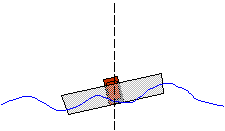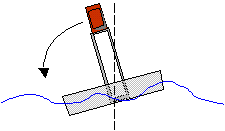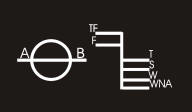FAQ's
Frequently Asked QuestionsTable of Contents
How does a steel boat float?Steel, iron or
aluminum boats float because the water displaced by the shape of
the hull equals the weight of the metal hull and whatever is
aboard. If you squeezed a baking pan into a cube of metal it
would sink because it does not displace it own weight in the
water. Left in the pans original shape, it would not only float
but would float if a brick was added to the pan because the
weight of the two objects would still be less than the maximum
displacement of the pan.
What is meant by stability on a boat?A boat is designed so it is stable in the water or it will tip and capsize. The weights and free surface liquids must be contained, distributed and separated on a boat so their influence will not upset the balance. If we use the baking pan again we can illustrate how this works.
Height
Free Surface
What is the difference between a barrel and a drum?The short
answer is: A barrel is a measurement of 42 gallons and a drum is
55 gallons in the marine and oil industry. What is dwt?Deadweight Tonnage. Sometimes termed deadweight carrying capacity, is the difference between the light and loaded displacements of a ship or barge. The Deadweight tonnage comprises the cargo, stores, ballast, fresh water, fuel oil, passengers, crew and their effects. What is Gross Tonnage?Gross tonnage is a measure of the internal capacity of a ship, tug or barge. It is a cubic or space measurement of all areas of a vessel with some allowances or deductions for exempt spaces such as living quarters. What is Net Tonnage?Net tonnage is a measure of the internal capacity of a ship, tug or barge's cargo space volume only.
What is light
weight tonnage?
Lightweight tonnage is the weight of the ship itself. The hull, machinery and all its fittings. Fuel, stores and crew are not included.
What is the
reason for the Plimsoll Mark (Load Line)?
Samuel Plimsoll, a British merchant and shipping reformer campaigned for this mark to prevent ships from being overloaded and lost at sea. His idea became law in Britain in 1875. The mark, a circle with a horizontal line through the center was painted on both sides of a ship. In order to keep their insurance a ship could not load deeper then this line. Until then a large number of ships would sink every year as owners and captains overloaded their ships to stay competitive. An International Load Line was adopted by 54 nations in 1930 and amended in 1968.
What do the
letters stand for on the Load Line?
The letters on the horizontal line through the center of the circle stand for the classification society, i.e.; AB is the American Bureau of Shipping, LR would be for Lloyds Register of Shipping, etc. The letters on the ladder lines to the side of the circle are as follows; TF is Tropical Fresh Water, F is Fresh Water, T is Tropical, S is Summer Season, W is Winter Season and WNA is Winter North Atlantic. Depending on what waters the ship is in at the time of loading, it cannot load above the corresponding mark.
|




